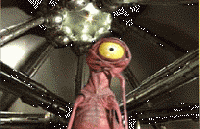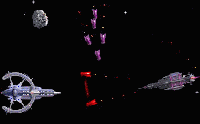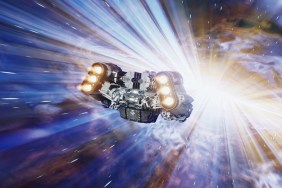Commander!
We’re in a strange quadrant of the galaxy, with no way back home, lost in the unknown reaches of an ever-expanding and possibly infinite universe that is in imminent danger of becoming a succulent entree on the inter-galactic buffet line of a group of pan-dimensional beings with an appetite, and your the only one who can save us!
Well… in that case, my social life can wait! I have a virtual universe to save! Such is the world of Star Control 3. A complete recreation of all that made Star Control 1 & 2 hits . . . and then some!
The story takes-off from where Star Control 2 ended. The Ur-Quan are defeated, and the formation of the League of Sentient Races assures peace and freedom for all sentience throughout the galaxy. Yet all is not well in the galactic core. The collapse of hyperspace cripples transportation and sends everyone into an awful tizzy. In steps the player. Being the only one with a ship that possesses the ability to travel through the stars, you assemble a small task force consisting of all the races of the League, including the newly-humbled Ur-Quan, and proceed to the galactic core… and your destiny!
Star Control 3 in
many ways can be considered an upgrade of Star Control 2 in almost every
way. As the action takes place in a new quadrant of the galaxy, the player is
introduced to a whole host of new alien species. The new species vary in their
traits and appearances so as to make the players interaction with each species
an interesting experience of it’s own. The new species include the enigmatic
Exquivan, dull-witted Doogs, cruel K’tang, plotting Ploxis, loathsome LK, and
the calculating Daktaklakpak. Alongwith the old tried and true races from the
former games, such as the Pkunk, Spathi, Chmmr, Mycons, Syreens, Ur-Quan and
the ever-popular, Humans. The player, for the most-part, must attempt to negotiate
an alliance with the different species through dialogs with each race. Talking
with the alien species is exactly as it was in Star Control 2, except
that the graphics have been improved. The aliens are no longer represented as
hand-drawn cartoons, instead they have been created using live-action puppets,
which makes the look a lot more realistic, helping to entice the player further
into the story.
Along with new species come new ships. All accounted for, there are 12 new ships in the game. Although the player can’t fly all of them in the adventure game, as they belong to either enemies or neutrals, there’s always Hypermelee! This new form of the good-old smash-em up Melee mode from the previous Star Controls takes the space battle into the third dimension. The Hypermelees are fought in the same way as in the originals, with ships still succumbing to the effects of their inertia as the attempt to maneuver around enemy gunfire, and the annoying gravity wells of nearby planets. The twist in the new game is the view of the action. Replacing the traditional top-down is a new isometric view of three dimensions, adding a whole new ‘depth’ to the battles. Added to this is the realistic graphics of the ships’, making them look like they were modeled in 3D. The basic mechanics of the battles however, remain the same. The ships can still only move in four directions while firing a primary and secondary weapon . . . they just look better a whole lot better while doing it.
 The adventure game itself
The adventure game itself
plays almost exactly like Star Control 2. There are four views of control
offered in the game. First, is the view of the quadrant, which allows the player
to navigate between the star systems. Navigation between star systems is carried
out by the simple click of a mouse-button that replaces the clumsy manual maneuvering
of Star Control 2. The interface for this view is very well done, allowing
the player to view all the known colonies, resources or ship strengths of each
star system while being able to single each one out by simply typing in the
first few letters of a system’s name. This view also allows the player to rotate
the map of the quadrant, reminiscent of Star Control 1, as it is three
dimensional. Second, is the view of the Star system the player is in. This view
allows the player to navigate an orbit around a particular planet and scan the
planets for resources. This view also allows the player to juggle around and
add or remove ships from his fleet. Third, is the view of the planet around
which the player’s fleet is orbiting. It is through this view that a player
can start up colonies, dig for artifacts, upgrade and maintain his ships, use
items in his inventory, trade resources with a colony or, most importantly,
talk to ICOM. ICOM is the friendly ships interface computer that is actually
a well designed hint system in disguise. Whenever the player is stuck, he can
strike up a dialogue with ICOM which give him useful advice on what to do next,
based on what has happened so far in the game. The fourth, and surprisingly
least involved system in the game, is the colony view. Once a colony is established,
the player can move to this view to do simply one of two things. The colony
has an automatic plan of construction, mining and ship-building. The player
is merely responsible for allocating manpower to the individual facilities of
the colony. The player can also study the progress of ship-building, research,
mining, or refining that is taking place in the colony. In truth this view is
simply that. All a player can do is view the colony as it grows without taking
an active role in it’s development. This reduces the role of the colony to merely
research station and ship building facility, allowing the player to focus primarily
on Space exploration and inter-special negotiation.
While all these elements of the game combine to make Star Control 3 a great sequel, there are a few niggling flaws that must be pointed out to the wary player. Initially, the game is extremely hard to get into. While the interface does retain the familiarity of the original Star Controls, it is still daunting, as it appears to be a lot more complex than it needs to be. Even the packaging presented a challenge, taking this reviewer at least ten minutes trying to figure out how to get the bloody CD out of the box! This is not a game that is easy to begin playing, it requires that the manual be handy by one’s side during the initial take-off. Compounding the initial frustration of the game are a few minor technical glitches, such as repeated flashing of the screen in the Hypermelee mode as switches it’s view of the battle and some needlessly long pauses in the game. So watch out all, if you can get past these growing pains rest assured you will be returned in full for your efforts.
In all Star Control 3 is a good game that maintains the excitement and feeling that made it’s predecessors classics, while adding enough improvements to insure it’s niche in gaming history.
-
A great sequel with a complex universe.
-
Not an original idea.
-
Some flaws that may cause frustration.











